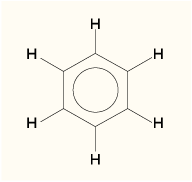Difference between revisions of "Benzene"
(→Notes) |
(→See also) |
||
| Line 46: | Line 46: | ||
[http://www.vliz.be/projects/endis/EDnorth.php?showchemprop=true&showeffects=true&chemeffects=true&chemid=152 Benzene on the ED North Database] | [http://www.vliz.be/projects/endis/EDnorth.php?showchemprop=true&showeffects=true&chemeffects=true&chemid=152 Benzene on the ED North Database] | ||
| − | |||
<P> | <P> | ||
<BR> | <BR> | ||
Revision as of 10:11, 27 August 2009
Definition of benzene:
Benzene is a colourless liquid with a sweet odor. It is highly flammable and is formed from both natural processes and human activities. [1]
This is the common definition for benzene, other definitions can be discussed in the article
|
Notes
| Benzene |
|---|

|
| Formula |
| C6H6 |
Benzene is widely used in the United States; it ranks in the top 20 chemicals for production volume. Some industries form benzene to produce other chemicals which are used to make plastics, resins, nylon and synthetic fibers. Benzene is also used to make some types of rubbers, lubricants, dyes, detergents, drugs and pesticides. Natural sources of benzene include volcanoes and forest fires. Benzene is also a natural part of crude oil, gasoline, and cigarette smoke.[1]
Anthropogenic releases of benzene into the atmosphere result mainly from environmental auto mobile exhaust and refuelling, tobacco smoke and industrial emissions.
Benzene has a moderate water solubility of 1,78 g/l, but is highly volatile and can rapidly evaporate from surface waters to the atmosphere. It has a low adsorption to sediments or soils and will be removed from them into surface or ground water and the atmosphere. In the atmosphere it will be degraded within 8 days, while its half-life in water is 16 days.
Benzene has a low tendency to bioaccumulate, concentrations in goldfish are typically only 4 times higher than those in the environment. Therefore it is not considered likely to biomagnify though food chains. [2]
The most sensitive crustaceans experience acute toxicity at benzene concentrations above 3.3 mg/l although most other crustaceans tolerate concentrations up to 120 mg/l. The most sensitive fish species die at exposure to concentrations above 4.9 mg/l, although most species tolerate short term exposure to benzene concentrations of up to 100 mg/l. [3]
Concentrations in air typically range between 0.3 ppb and 159 ppb. The highest measured concentration of benzene in marine waters is 315 µg/l. [2]
Environmental standards and legislation
Included in the water framework list of priority substances
See also
Benzene on the ED North Database